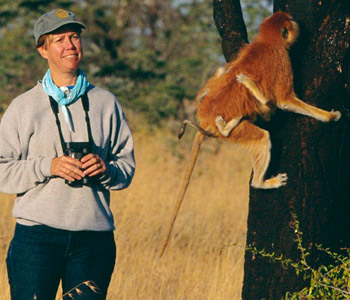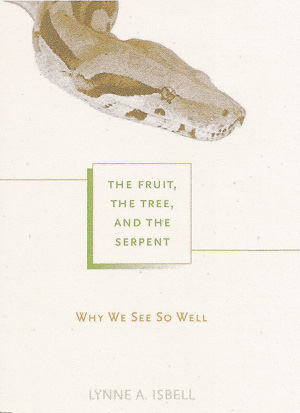
The Fruit, the Tree, and the Serpent is the result of my attempt to understand what in the environments of proto-primates might have begun the process of brain modification to expand the visual sense beyond that of other mammals and turn them into what we today call primates.
The currently most widely accepted hypothesis developed to explain why primates evolved linked the traits of good vision and visually guided reaching and grasping via the same selective pressure, that of an insectivorous diet which would have necessitated accurate judgment of distance to insect prey and the ability to catch those insects in the hands.
In The Fruit, the Tree, and the Serpent I provide evidence against this hypothesis. I use recent findings from neuroscience that suggest these traits are not, in fact, inextricably linked. Indeed, it is not even clear anymore that all primates have visually guided reaching and grasping, at least for obtaining their food. Certainly the anthropoid primates (the primate lineage to which we belong) have this ability. But some of the prosimian primates, the lemurs and bushbabies, may not.
I briefly discuss the selective pressures that might have favored visually guided reaching and grasping (forelimb-directed travel in an arboreal environment), but the main emphasis of the book is on explaining other aspects of our enhanced visual sense: our forward-facing eyes, sharp visual acuity, and good color vision, among other qualities. The bottom line: primates have good visual ability not because early primates were predators but because they were prey—notably of constricting snakes, their first predators.
But there’s more to primate evolution than their origin. Although all primates have an expanded visual sense, there is also variation in visual ability within the primate lineage. For example, not all primates see equally clearly and not all primates can distinguish reds from greens. Such variation also needs explaining. The Fruit, the Tree, and the Serpent provides evidence that variation in visual ability among primates is ultimately the result of differential exposure of primates on the landmasses of Madagascar, Central/South America, and Africa/Asia to another deadly threat, that of venomous snakes.
Bringing it back to ourselves, we have superb vision because our own lineage within the primates arose in Africa/Asia, where the longest and most unrelenting evolutionary exposure to venomous snakes occurred.
“Primates have good visual ability not because early primates were predators but because they were prey—notably of constricting snakes […] we have superb vision because our own lineage within the primates arose in Africa/Asia, where the longest and most unrelenting evolutionary exposure to venomous snakes occurred.”
The idea of Snake Detection actually took me by surprise. I wasn’t looking for it. I was instead pursuing answers to questions that were more consistent with my academic background in primate behavioral ecology. I had been wondering how long ago the various predators of primates appeared on the landmasses of Africa/Asia, Central and South America, and Madagascar. These regions are home to distinct lineages of primates: Old World monkeys and apes (the primate lineage leading to humans), New World monkeys, and lemurs, respectively. Each lineage has distinct behavioral characteristics, including the degree to which females disperse from their natal groups and areas.
What I wanted to find out was whether a longer evolutionary history with predators might be associated with an increase in the tendency of females to stay at home. All I knew about primate vision at the time was that primates on these landmasses differed broadly: Malagasy lemurs have poorer visual acuity than the others (because most lack a fovea for sharp central vision), and most New World monkeys have poorer color vision than Old World monkeys and apes.
As I investigated the question of variation in female dispersal, I came across a reference to a now 30-year-old paper about retroviral transmission from primates to a venomous snake in Asia that apparently occurred quite long ago. Although I knew constricting snakes, the pythons and boas, were predators of primates, I had never really thought about venomous snakes as predators—most of today’s primates are too large to be eaten by them.
Knowing what we know now about retroviral transmission—think of HIV—the inference I drew from the paper was that somewhere in Asia there had been a moment in ancient time when a venomous snake made contact with a primate. This struck me as good indirect evidence that venomous snakes were predators of primates in ancient times; or, at the very least, that venomous snakes were deadly to primates. As we humans know all too well, especially those of us living in the tropics where most primates also live, venomous snakes don’t need to consume us to be deadly.
I followed up on the idea and found that visual ability in primates gets better with longer evolutionary time with venomous snakes.
Venomous snakes first appeared in Africa/Asia about the same time that anthropoid primates appeared. African monkeys and apes (which constitute the lineage leading directly to humans) and Asian monkeys have always had to avoid stepping too near to snakes that could kill them with one bite. Perhaps not coincidentally, they have the best vision of all primates. At the other extreme, venomous snakes have never occurred in Madagascar, and the prosimians there have poorer visual acuity than other primates. Most prosimians also cannot distinguish reds from greens.
Venomous snakes eventually spread from Asia to North America, and finally to South America. The monkeys that live in Central and South America are thought to have originated in Africa, rafting over on floating islands dislodged from the mainland. Their ancestors were exposed to venomous snakes before arriving in the New World. But when these monkeys reached South America, they found themselves in a continent free of venomous snakes. So they began to diversify released from the constraints venomous snakes imposed on their ancestors. Today, not only do New World monkeys have visual abilities intermediate between those of Malagasy prosimians and Old World monkeys and apes, they also have more variability in the details of their visual systems. As the Snake Detection theory predicts, variability would be expected to increase in a less constraining environment.
Reconstructing evolutionary paths that eventually led to what we have in the world today is challenging. We can never really know what exactly happened millions of years ago. All we can do is postulate what might have happened and look at the evidence currently available to decide if what we propose is reasonable. That is what The Fruit, the Tree, and the Serpent does.
I’m intrigued about the implications of the Snake Detection theory for human behavior, and, in the epilogue, I write most directly about humans.
Have you ever wondered about our ability to point for the purpose of sharing attention? My guess is probably not. But this truly is a special ability. A boy pointing up in the sky and saying, “Look! It’s a bird! It’s a plane! It’s Superman!” directs others to an object for the purpose of sharing attention. “Declarative pointing,” as this is called, is apparently unique to our species.
But why us and not any other species? What in our ancestors’ environment prompted the evolution of declarative pointing only in us?
Pointing draws our eyes closer to the target. If we want someone else to see a venomous snake barely visible in the grass, for instance, we might point to it to make it easier to find—and avoid. It turns out that we are more accurate at pointing down than up and quicker at responding when someone else points down rather than up. We also automatically look in the direction of the pointing finger—unless we purposely refuse to do so. In an environment with cryptic snakes and without the luxury of snake gaiters, these responses would seem quite helpful for reducing the frequency of deadly snakebites.
From the time our ancestors began to walk upright, the threat from snakes has come largely from the ground. But accompanying this new posture were eyes that were farther away from the ground and perhaps less effective at detecting well-camouflaged snakes. Those who happened to detect such snakes and point to share attention to them would have helped save others’ lives; those who responded most quickly and automatically would have been helped even more.
I link declarative pointing with social relationships. Think about this: we don’t point when we’re alone. Interestingly, declarative pointing is also closely linked with language, another skill done in a social context. For instance, the extent of infants’ involvement in declarative pointing (both their own and their mothers’) predicts the extent of vocabulary development when they become toddlers. People with autism don’t point declaratively nor do they have well developed language skills.
Gestures in general are often argued to have been a precursor to language. Is it possible that declarative pointing as a specific gesture helped facilitate the evolution of language? If so, then snakes could have led the way.
“We automatically look in the direction of the pointing finger—unless we purposely refuse to do so.”
If I were to be granted one wish arising from The Fruit, the Tree, and the Serpent, it would be for readers to begin to see life a little differently. Some might understand deep time and evolution better. Others might appreciate more what our wonderful brains can do. Some might realize that they have greater control over themselves than they thought. Some might learn just how close is our biological connection with other mammals. Some might replenish their awe for life and the world that supports it all. Some might even begin to like snakes more. Some might be inspired to test the predictions presented in the book. Some might combine their talents to form interdisciplinary collaborations to conduct the tests.
I would love to see the Snake Detection theory more thoroughly tested than I have been able to do. That is the only way to determine if it will have lasting scientific merit. Right now, the Snake Detection theory is just at the stage that the theory of evolution by natural selection was at the time Charles Darwin published On the Origin of Species.
We have continued to test Darwin’s theory, and each test seems to make it stronger. I don’t know if the Snake Detection theory will have similar success. I would like it to, of course. But even if it doesn’t, that’s okay. In the process of finding out, we will gain greater understanding of who we’ve been, who we are, and our place in the world, both as the world has changed over the millions of years that it’s been our home and as it changes so rapidly now.


Lynne Isbell is a professor of anthropology and animal behavior at the University of California, Davis. Since 1980 she has focused her field research in East Africa, where she has conducted long-term studies on the behavior and ecology of red colobus monkeys in Uganda, and vervets and patas monkeys in Kenya. She has authored over 60 papers in numerous edited volumes and journals, including the Journal of Human Evolution, International Journal of Primatology, Behavioral Ecology and Sociobiology, American Journal of Physical Anthropology, and Animal Behaviour. She has had several close encounters with venomous snakes.